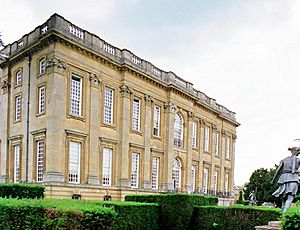George Fermor, 2nd Earl of Pomfret facts for kids
George Fermor, 2nd Earl of Pomfret (1722–1785), was an important person in British history. He held the title of Earl of Pomfret, which is a noble rank in Great Britain. Before he became Earl in 1753, people called him Viscount Leominster. His family home was Easton Neston house in Northamptonshire.
George was the oldest son of Thomas Fermor, 1st Earl of Pomfret and Henrietta Louisa Jeffreys. He joined the British Army in January 1739 as a lieutenant. He served in different regiments, including Pearce's Regiment of Horse and the Coldstream Guards. By 1746, he was a captain. He left the army around January 1752.
When his father passed away in 1753, George became the 2nd Earl of Pomfret. He spent a lot of money, so he had to sell many things from his home, Easton Neston. This included valuable sculptures. These sculptures were once part of the famous Arundel marbles. George's grandfather, William Fermor, 1st Baron Leominster, had bought them earlier. Luckily, George's mother bought the sculptures from him. She then gave them to the University of Oxford so they could be kept and studied.
In 1763, George became a Gentleman of the Bedchamber. This was an important role in the royal household. In 1771, he was made a privy counsellor, which meant he advised the King.
His Family Life
In 1764, George Fermor married Anna Maria Delagard. Their wedding took place at St. James's Church in Westminster. Anna Maria (c.1736-1787) was the sister of William Delagard from Bombay. She was also the granddaughter and heir of William Draycott. After her grandfather died in 1753, Anna Maria took on the Draycott family name.

Anna Maria inherited a large amount of money and estates. Some of this came from Lady Mary Coke, who was the widow of Robert Coke. Lady Mary was also the sister of Philip Wharton, 1st Duke of Wharton. Lady Jane Coke, another relative, left valuable mineral mines to Anna Maria in 1760. These mines were in Fremington, Yorkshire. Lady Jane had raised Anna Maria since she was a child. Anna Maria showed her thanks to Lady Jane by putting up a monument for her in St Mary's Church, Sunbury.
George and Anna Maria had three children:
- George Fermor, 3rd Earl of Pomfret (1768–1830), who did not have any children.
- Thomas Fermor, 4th Earl of Pomfret (1770–1833).
- Lady Charlotte Fermor (1766–1835). She married her drawing teacher, Peter Denys. Lady Charlotte lived in Chelsea and also inherited the mining interests in Yorkshire.
Images for kids



